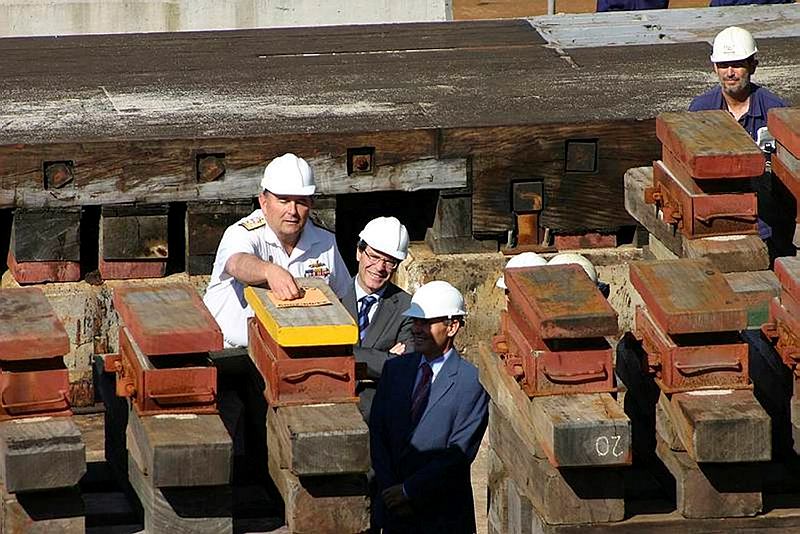‘A 30-40% premium’, ‘3 AWDs for the cost of 9’, ‘500 more jobs in SA for future submarine sustainment’—all snapshots from recent Government media releases. The Government appears to be preparing the political ground for a decision to buy ships and submarine from overseas instead of building them in Australia.
I recently wrote on the necessity and benefits of building Australia’s Future Submarines in Australia. However, the Minister for Defence’s recent endorsement of the RAND Report on the future frigate program caused me to review other studies on warship building in Australia in the search for yardsticks.
The AWD project has been in the news recently for all the wrong reasons. It involves some notable features and follies, including:
- specially adapted ships from an overseas designer with no experience of exporting/transferring its design and production technology
- a production run of three ships, with little chance to achieve significant productivity improvements
- failure to adopt a comprehensive, modern information management system; not even the purchase of a full suite of CAD/CAM drawings
- the Alliance arrangement places the DMO on both sides of the contract and diffuses responsibility
- selection of a government-owned company (ASC) that had never built a surface combatant via a ‘beauty parade’, with no fixed price performance obligations
- failure to include the ship designer in the Alliance
- starting with a ‘greenfield’ shipbuilding site
I suggest that the man hours required to construct those ships is heavily distorted by those arrangements, and are no guide as to what could be achieved by an Australian workforce building future frigates.
In short, the AWD project is a demonstration of how not to do the future frigates! The previous Australian frigate program, the Anzac ship project, provides a far more appropriate starting point.
As a Defence SA paper published in November 2009 observes, the Anzac ship project:
- involved an open international competition for existing designs to be built in Australia by a predominantly Australian prime contractor
- used an existing design already in operational service, mandated to reduce capability risks and reduce non-recurring engineering effort
- had a performance-based, fixed-price contract directly with the Australian prime contractor, who then sub-contracted ship design, combat system and propulsion system design/supply and all other equipment procurement
- successfully delivered the eight frigates for Australia and two for New Zealand on time/cost, meeting all of the major Defence requirements specified
- exhibited significant learning curve
- managed risks well with a comprehensive land-based testing regime before installation of equipment in the ships.
Based on advice provided by DMO to the Senate, the Anzac project achieved 92% of the productivity achieved in the long running DDG 51 program. Australia’s capacity to mobilise a high-tech workforce capability is one of the lessons we should draw from this example.
A Tasman Asia Pacific Study into the Anzac Ship project (PDF) found many favourable impacts for the Australian economy and a modest cost premium of 3.0 – 3.5%, more than offset by economic benefits flowing from the project.
It also found many non-economic spin-offs, observing that the 780 Australian suppliers involved became more innovative through their own R&D and access to foreign technology, improved their business practices, increased export opportunities and acquired new defence capabilities.
Similarly, the 2006 Senate review into Australian shipbuilding was in no doubt as to the overall economic and strategic benefits of local construction:
‘… it is in Australia’s national interest to maintain a viable naval shipbuilding and repair industry. This requires a commitment by the Government to have Australian naval vessels constructed in Australia.’
A 2013 study by ACIL-Allen (PDF) quantified the potential economic value measured in terms of GDP of naval shipbuilding and through life support to Australia:
- a $100 million increase in naval shipbuilding would increase GDP by $73–104 million,
- while $100 million in through life support would increases GDP by between $80–136 million.
The picture emerging from the studies cited is of construction premiums significantly less than the 30–40% quoted for the AWD, offset by the economic boost to GDP, technology spin offs and increased strategic benefits from a local supply chain to increase availability.
I think it’s reasonable to conclude that:
- there’ve been enough studies upon which to base the policy for building Australia’s future submarine and the frigates
- we should be looking to the most efficient shipbuilders for assistance in setting up and undertaking the future frigate project in Australia.
Building future submarines and frigates overseas would wipe out the hard earned IP, knowledge and skills built up via the Collins, Anzac and dare I say it, AWD projects. Are we seriously considering handing these economic and skill benefits for constructing future submarines and frigates to overseas builders at the expense of Australian Industry?
From a strategic perspective; self-reliance, minimising the cost of ownership and ensuring access to all the information and skills necessary to achieve high availability from modern, capable ships and submarines; there are strong benefits if we build the frigates and the submarines in Australia—the Government should direct this as the starting point for both projects.


